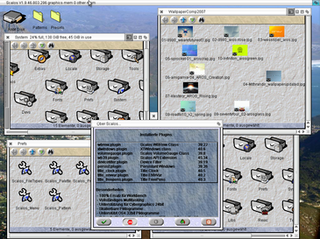AmigaGuide is a hypertext document file format designed for the Amiga. Files are stored in ASCII so it is possible to read and edit a file without the need for special software.
Amiga E, or very often simply E, is a programming language created by Wouter van Oortmerssen on the Amiga. He has since moved on to develop the SHEEP programming language for the new AmigaDE platform and the CryScript language used during the development of the video game Far Cry.
Racter is an artificial intelligence computer program that generates English language prose at random.
Delta 4 was a British software developer created by Fergus McNeill, writing and publishing interactive fiction.
Hoi is an Amiga platform action video game created in the early 1990s. It features a lime green character named Hoi. The game became notable for being the first to contain a seizure warning on the label, due to the last level's flashy design.
Aminet is the world's largest archive of Amiga-related software and files. Aminet was originally hosted by several universities' FTP sites, and is now available on CD-ROM and on the web. According to Aminet, as of 1 April 2013, it has 80592 packages online.
Epic is a space flight simulator game developed by Digital Image Design and published by Ocean Software for the Amiga and Atari ST in early 1992, with ports for MS-DOS and the NEC PC-9801 later the same year. A sequel titled Inferno was released for the PC CD-ROM in 1994.

Amiga Format was a British computer magazine for Amiga computers, published by Future plc. The magazine lasted 136 issues from 1989 to 2000. The magazine was formed when, in the wake of selling ACE to EMAP, Future split the dual-format title ST/Amiga Format into two separate publications. At the height of its success the magazines sold over 170,000 copies per month, topping 200,000 with its most successful ever issue.
Amiga software is computer software engineered to run on the Amiga personal computer. Amiga software covers many applications, including productivity, digital art, games, commercial, freeware and hobbyist products. The market was active in the late 1980s and early 1990s but then dwindled. Most Amiga products were originally created directly for the Amiga computer, and were not ported from other platforms.

Super Monaco GP (スーパーモナコGP) is a Formula One racing simulation video game released by Sega, originally as a Sega X Board arcade game in 1989, followed by ports for multiple video game consoles and home computers in the early 1990s. It is the sequel to the 1979 arcade game Monaco GP.

Amiga Reflections is 3D modeling and rendering software developed by Carsten Fuchs for the Commodore Amiga. It was later renamed Monzoom.
Imagine was the name of a cutting-edge 3D modeling and ray tracing program, originally for the Amiga computer and later also for MS-DOS and Microsoft Windows. It was created by Impulse, Inc. It used the .iob extension for its objects. Imagine was a derivative of the software TurboSilver, which was also for the Amiga and written by Impulse. CAD-Technologies continued the distribution of the Amiga version. Starting with version 5.1, new updates were available for free for current customers as part of the Amiga Constant Upgrade Program (ACUP) up until presumed Imagine 6.0 release.

Elfmania is a 2D fighting game developed by Terramarque and released by Renegade Software in 1994 for the Amiga.

Miggybyte was a free disk-based magazine for the Amiga range of computers, published by Pickled Fish Software and edited by Ben Gaunt. From 1995 to 1997 twelve issues were published all being on a single floppy disk only.

Super Cauldron is a scrolling platform game released by Titus Software in 1993.

Scalos is a desktop replacement for the original Amiga Workbench GUI, based on a subset of APIs and its own front-end window manager of the same name. Its goal is to emulate the real Workbench behaviour, plus integrating additional functionality and an enhanced look. As stated on its website, the name "Scalos" was inspired by the time-accelerated planet Scalos from the Star Trek TV series' fictional universe.
Retargetable graphics is a device driver API mainly used by third-party graphics hardware to interface with AmigaOS via a set of libraries. The software libraries may include software tools to adjust resolution, screen colors, pointers, and screenmodes. It will use available hardware and will not extend the capabilities in any way.

Rashumon was a multilingual graphical word processor developed for the Amiga computer by an Israel-based company called HarmonySoft and was sold until after the demise of Commodore in 1994. Rashumon had particular support for Hebrew, Arabic and Russian as well as English, and it could send its text to speech synthesis in English.

Installer is a scripting language developed by Commodore International for AmigaOS, first released for version 2.1 in 1992. Its grammar is based on the LISP programming language. A compatible re-implementation named InstallerLG is actively developed as of October 2018.

Theme Park Mystery is an adventure video game developed by Brian Howarth and Taeman Irmak released in 1990, for the Commodore Amiga published by Konami. It was also released to the Atari ST and also DOS later in 1990. The game features themes and activities surrounding a haunted and gruesome amusement park.











